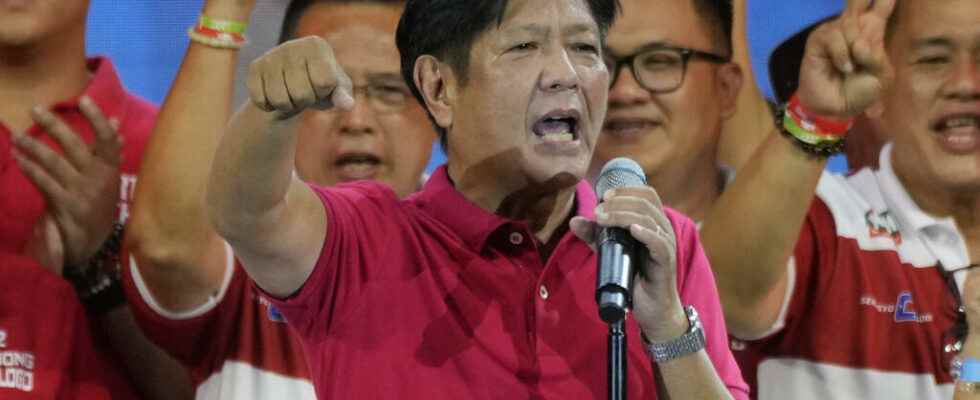The victory of Ferdinand Marcos junior, son of the late dictator, in the presidential election in the Philippines signals the return to grace of a family clan driven from power 36 years ago by a popular revolution. A look back at the Marcos dynasty saga.
Thirty-six years after being driven out, the Marcos clan will return to Malacanang Palace next July. Ferdinand Marcos junior will then succeed Rodrigo Duterte as head of the country, following his landslide victory in the presidential election of May 9.
The family is familiar with this gleaming, pristine white palace on the banks of the Pasig River in Manila, the capital of the Philippines. Because it is from here that the father of the future president, Ferdinand Marcos senior, reigned supreme for 21 years, supported by his wife Imelda, a former beauty queen from a powerful dynasty in the center of the country. It is also from this same opulent presidential residence that the family had to be exfiltrated in extremis by helicopter in 1986, with the building stormed by thousands of angry protesters. They will discover an impressive collection of thousands of shoes belonging to Imelda Marcos, known for her taste for luxury.
A long dictatorship
Since this incredible and shameful flight from the Marcos family, the clan has been able to restore its image to reclaim its place among the dynasties that reign over this Asian archipelago of 110 million inhabitants. Theirs dates back to 1965 when Ferdinand Marcos first came to power. He was re-elected four years later, despite allegations of corruption.
After two terms as head of state, instead of leaving as required by the Constitution, he decreed martial law on September 21, 1972 to stay in power. Strong with the support of the United States, Ferdinand Marcos rules by decree and carries out a violent repression against the opposition. Tens of thousands of dissidents are imprisoned, tortured and even killed.
When opposition leader Benigno Aquino returned from exile in the United States in 1983, he was assassinated by Marcos’ men at Manila airport. Huge demonstrations then demand the resignation of the dictator, in vain. Three years later, still under pressure from hostile public opinion, Ferdinand Marcos announced an early presidential election on American television. The widow of the murdered opponent, Corazon Aquino, then comes out of the shadows and decides to come forward.
At the end of this election marred by fraud and violence, the dictator in place proclaims himself the winner, but he will not resist the anger of the street for long. Called to civil disobedience by the unsuccessful candidate Corazon Aquino and supported by the bishops of the island, the Filipinos demonstrate by the hundreds of thousands in the streets of Manila, thus triggering the revolution of “power of the people”.
Washington finally withdrew its support for the Marcos family, and on February 25, 1986, the family had to flee the Philippines for exile in Hawaii. The way is then clear for Corazon Aquino who becomes president and promises to find some 10 billion dollars of public funds embezzled by the Marcos clan.
The clan reweaves its network
Barely two years after the deposed dictator died in exile in 1989, former first lady Imelda Marcos returns home to stand trial for fraud and massive corruption. But despite decades of lawsuits, no member of the Marcos family will be imprisoned. Little by little, the clan reweaves its network and manages to gain political influence in the Philippines again. In 1992, Ferdinand Marcos junior won his father’s former seat in Congress, before becoming governor and senator in the family stronghold of Ilocos Norte in 2010.
In 2016, the dictator’s son lost the race for the vice-presidency by a small margin, but Ferdinand junior, who liked to praise his father’s “political genius”, was not discouraged. The man nicknamed “Bongbong” declares his presidential candidacy five years later, in October 2021. Against all expectations, he forms an alliance with the eldest daughter of the outgoing president, Sara Duterte. The duo rely on a torrent of propaganda and fake news spread on social networks to make believe that the unchallenged reign of the late Ferdinand Marcos between 1965 and 1986 was a true golden age in the Philippines, punctuated by growth and public investments.
This narrative, which ignores years of corruption and authoritarianism, is paying off: on May 9, 2022, Camp Marcos wins against its main rival, outgoing Vice President Leni Robredo. A victory that marks the return to grace of the Marcos, long considered “pariahs” by the Filipinos.
► To listen also: Asia Frequency – Elections in the Philippines: the end of the Duterte era
